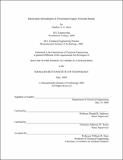| dc.contributor.advisor | Donald R. Sadoway and Jefferson W. Tester. | en_US |
| dc.contributor.author | Stern, Heather A. G. (Heather Ann Ganung) | en_US |
| dc.contributor.other | Massachusetts Institute of Technology. Dept. of Chemical Engineering. | en_US |
| dc.date.accessioned | 2007-01-10T15:34:01Z | |
| dc.date.available | 2007-01-10T15:34:01Z | |
| dc.date.copyright | 2006 | en_US |
| dc.date.issued | 2006 | en_US |
| dc.identifier.uri | http://hdl.handle.net/1721.1/35284 | |
| dc.description | Thesis (Ph. D.)--Massachusetts Institute of Technology, Dept. of Chemical Engineering, 2006. | en_US |
| dc.description | This electronic version was submitted by the student author. The certified thesis is available in the Institute Archives and Special Collections. | en_US |
| dc.description | Includes bibliographical references. | en_US |
| dc.description.abstract | While chromated copper arsenate (CCA) has proven to be exceptionally effective in protecting wood from rot and infestation, its toxic nature has led to the problem of disposal of CCA-treated lumber and remediation of waters and soils contaminated by process wastes. The active ions in water-based CCA are hexavalent chromium, divalent copper, and pentavalent arsenic. The objective of this study was to develop the underlying engineering science for remediation of aqueous CCA wastes via electrolytic deposition of neutral arsenic, chromium, and copper in order to evaluate the technical feasibility of this process. The specific approach focused on electrochemical stability analysis of the metals; development and testing of a copper sulfate reference electrode (CSE); electrolytic deposition of arsenic, chromium, and copper from model aqueous CCA wastes; and characterization of the resulting deposits. The electrochemical stability analysis of the individual components, As, Cr, and Cu, in an aqueous system was used to determined the most thermodynamically stable forms of the metals as a function of pH and electrochemical potential. This analysis predicted that under the conditions of codeposition of all three metals, hydrogen and arsine would also be produced. | en_US |
| dc.description.abstract | (cont.) A robust and accurate CSE was designed, constructed, developed and used as a reference electrode for the electrolytic deposition experiments in this study. The potential of the CSE as a function of temperature over the range of 5 to 45 °C was measured and related to the normal hydrogen electrode potential (317 mV at 25°C, slope of 0.17 mV/°C). Electrolytic deposition was performed using working and reference electrodes specially designed and fabricated for this study. Despite the results of the electrochemical stability analysis, conditions were found experimentally where arsenic, chromium, and copper were deposited from model aqueous CCA type-C solutions over a range of concentrations without the formation of arsine or hydrogen. Three different types of deposits were observed. One type contained a ratio of metal concentrations similar to that of CCA type-C and is a good candidate for use in CCA remediation and recycling processes. This study indicated that CCA remediation via electrolytic deposition is probably feasible from an engineering perspective. | en_US |
| dc.description.statementofresponsibility | by Heather A.G. Stern. | en_US |
| dc.format.extent | 193 p. | en_US |
| dc.format.extent | 6500930 bytes | |
| dc.format.extent | 6500708 bytes | |
| dc.format.mimetype | application/pdf | |
| dc.format.mimetype | application/pdf | |
| dc.language.iso | eng | en_US |
| dc.publisher | Massachusetts Institute of Technology | en_US |
| dc.rights | M.I.T. theses are protected by copyright. They may be viewed from this source for any purpose, but reproduction or distribution in any format is prohibited without written permission. See provided URL for inquiries about permission. | en_US |
| dc.rights.uri | http://dspace.mit.edu/handle/1721.1/7582 | |
| dc.subject | Chemical Engineering. | en_US |
| dc.title | Electrolytic remediation of chromated copper arsenate wastes | en_US |
| dc.title.alternative | Electrolytic remediation of CCA wastes | en_US |
| dc.type | Thesis | en_US |
| dc.description.degree | Ph.D. | en_US |
| dc.contributor.department | Massachusetts Institute of Technology. Department of Chemical Engineering | |
| dc.identifier.oclc | 71824582 | en_US |
